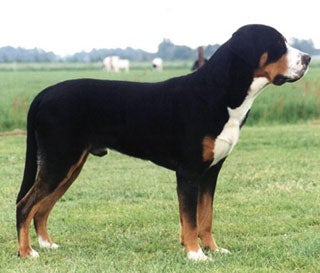Learn about dog breeds
Detailed information & photos on over 190 different breeds
Description
The Greater Swiss Mountain dog is a large breed, which originates from the mountainous regions of the Swiss Alps. You will find that this dog is a great worker and an excellent family dog. Not only will this dog strive to make its owners proud it will also excel in any work it is prompted to complete.
This large breed has a strong neck, chest, and legs. You will notice that the chest protrudes and the shoulders are flat and sloped. The legs are straight and feet are large. You will also notice the arched toes on this breed, which gave them an advantage in the Swiss Alps.
When you look at the Greater Swiss Mountain dog, he looks like a gentle dog and its temperament matches this. Its eyes are almond brown. This dog also has medium sized ears that are high on its head and are triangular. When this breed is scared or at attention the dog's ears stand up and forward. The muzzle is large and straight.
Coat Description
This dog has fur that is approximately 2 inches long. This dog has three colored coats. The undercoat is dense. You cannot see the undercoat anywhere on the body except at the neck, which is completely acceptable.
History
Considered largest of the Sennenhund Breeds the Greater Swiss Mountain Dog from Swiss Alps' farms and villages came to the United States in 1967. The ancestors of this dog are the Roman Mastiff. Due to its natural abilities for drafting, many gave this breed the name, "poor man's horse." Another dog breed related to the Greater Swiss Mountain Dog is the Saint Bernard. Many people have chosen the Saint Bernard species over the Greater Swiss Mountain Dog.
Temperament
If you purchase the Greater Swiss Mountain dog as a puppy you will find that they are hyper pups who are also very friendly. These pups do chew on things and will bark excessively at times. Make sure to provide enough stimulation and suitable chewing options so they don't get into trouble. This phase of the pup's life usually lasts for two to three years. There is a lot of training during this time since the puppy cannot differentiate between good and bad.
This is not an aggressive breed and makes an excellent family dog. You will find that this breed is loyal and protective. If you are looking for a watchdog for your home, you will find this in the Greater Swiss Mountain dog. Children and other family members get along great with this breed and the love to be around the family at all times. If you have other pets, you will not have to worry about this dog being overly territorial or aggressive to the other animals. You do not want to just throw your new pets together immediately but introduce them slowly so they can get to know each other.
Health Problems
Like all dogs, the Greater Swiss Mountain dog is susceptible to diseases and medical conditions. It is wise to keep this dog healthy so you can help its chances of not suffering from these illnesses later in life.
[-]If you feed your dog too much food or water at one time, he or she may have a Gastric Torsion. This is an untreatable condition and will need surgery.[/-]
[-]Epileptic episodes are also common in the Greater Swiss Mountain dog.[/-]
[-]A condition that some dogs in this breed can have is Distichiasis, which is when the eyelashes curl into the eyes. This can cause a lot of pain and irritation for the dog.[/-]
[-]Like many large breeds of dogs, the Greater Swiss Mountain dog is susceptible to Hip Dysplasia. This is a condition where the ball and joint of the hip has arthritis, which causes pain and difficulty in walking or running. Another similar joint problem is in the elbow known as Elbow Dysplasia.[/-]
Exercise is a great way to help a dog stay healthy and is one of the best ways to keep him safe from Hip or Elbow Dysplasia. Exercise is just as important for the Greater Swiss Mountain pup as in maturity.
Grooming
You will not have to maintain much of this dog's coat. They do not shed very much and only sheds in abundance twice a year. You should only have to brush your dog once a week and maybe twice during shedding season. When brushing, use a wire bristle brush so you can get to the undercoat of this dog.
The best way to bathe this dag is at a professional groomer. You will need a large size bath to bath this dog at home. When bathing at home it is important that you rinse all of the shampoo off the dog or skin irritation can occur. If you bring your dog home as a pup, make sure you train him to stay still while taking a bath and brushing.
Exercise
Exercise is essential for this dog especially as a puppy. Remember, they are bred to work and live on mountainous areas which means they have lots of room to roam. You will need to ensure that you provide your dog with enough stimulation or you dog will become bored and find ways to occupy himself that may not be desirable to you.
Training
Training this breed means that you have to be firm and consistent. You will need to begin training your pup at the age of 6 weeks. This will ensure that you dog understands that you are the dominate person in the pack. If not, your dog will have behavioural problems in the future. Socialization is the most important part of training. Be sure to expose him to as many people and other dogs as possible.
Advertise | Privacy Policy | Terms of Use | Contact Us © Copyright 2004-2024 PupCity.com. All rights reserved.
